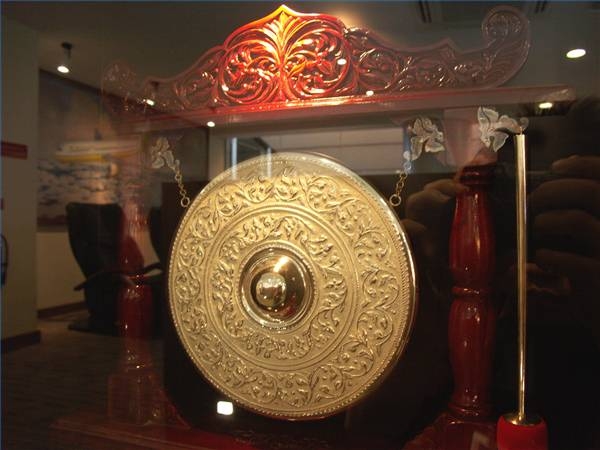Early Uses of Sound
The use of musical tones in medicine date back to ancient China. Musical notes were based upon the Five Element and Yin-Yang theory. Notes are associated with the five elements which are associated with the organs of the body.
ELEMENT ORGAN NOTE Color
Wood liver Jue (E) green
Fire heart Zhi(G) red
Earth spleen Gong(C) yellow
Metal lung Shang(D) white
Water kidney Yu(A) black
An illness or disease can be associated by a weakness of an organ or by over activity of an organ. A weakness of the heart (Fire) can be treated with music played in the Jue note (E) as Wood gives rise to Fire. On the other hand, an illness associated with the over activity of the heart can be controlled with music played in Yu note (A) as Fire is overcome by Water. A weakness or over activity of an organ determines the state of our physical being. Musical notes can cool down or elevate the activity of an organ.
When we are feeling sick, our mood and how we feel about things also changes. Although musical notes were used for the physical aspects of our well being, an added benefit was the effect the treating note had upon our psychological and emotional well being.
Sound was also used in the form of Chants or Mantras. This method was widely used by monks and proved useful when no musical instrument was available. By humming or making other sounds, they could produced sound and vibration to strengthen, balance, and cleanse the energy centers (Chakras) of the body. Relaxation, meditation, and sound provided the recipe to a healthier body and a way to attain intellect and enlightenment.
Other instruments used to produce sound and vibration for healing and meditation included the singing bowls. Bowls of different sizes and different instruments used with the bowls produced sound unlike traditional instruments and added an effect of their own. Another instrument used was the gong. The gong worked primarily with vibrations and came in different sizes and a wide range of sounds could be produced. Drums and flutes are widely used for meditation.
Modern Time Uses of Sound Therapies
Heinrich Wilhelm Dove discovered binaural beats in 1839. While research about them continued after that, the subject remained something of a scientific curiosity until 134 years later, with the publishing of Gerald Oster's article "Auditory Beats in the Brain" (Scientific American, 1973). Oster's article identified and assembled the scattered islands of relevant research since Dove, offering fresh insight (and new laboratory findings) to research on binaural beats.
Binaural beats are auditory brainstem responses which originate in the superior olivary nucleus of each hemisphere. They result from the interaction of two different auditory impulses, originating in opposite ears, below 1000 Hz and which differ in frequency between one and 30 Hz (Oster, 1973).For example, if a pure tone of 400 Hz is presented to the right ear and a pure tone of 410 Hz is presented simultaneously to the left ear, an amplitude modulated standing wave of 10 Hz, the difference between the two tones, is experienced as the two wave forms mesh in and out of phase within the superior olivary nuclei. This binaural beat is not heard in the ordinary sense of the word (the human range of hearing is from 20-20,000 Hz). It is perceived as an auditory beat and theoretically can be used to entrain specific neural rhythms through the frequency-following response (FFR)--the tendency for cortical potentials to entrain to or resonate at the frequency of an external stimulus. Thus, it is theoretically possible to utilize a specific binaural-beat frequency as a consciousness management technique to entrain a specific cortical rhythm.
 |
Monaural beats are used for brainwave entrainment in which two tones which would be used binaural beats are played in each channel resulting in a stronger stimulus. With monaural beats, the interference pattern that produces the beat is outside the brain so headphones are not required. They differ from isochronic tones because monaural beats are a sine wave pulse rather than entirely separate pulses of a single tone.
 |
Isochronic tones are regular beats of a single tone used for brainwave entrainment. Similar to monaural beats, the interference pattern that produces the beat is outside the brain so headphones are not required, but since isochronic tones are more pronounced, the stimuli is even stronger. They differ from monaural beats which are a sine wave pulse rather than entirely separate pulses of a single tone.Isochronic tones work by the contrast between the "on" and "off" settings in the noise. because off is nothing, and on is on, there is a high level of contrast. this contrast causes your brain to change its thought patterns.

|
It is the small difference in the two wave forms that has sparked the interest in how the mind could be manipulated and trained to function at a higher or lower level, depending upon the need. The binaural beats alone might be disturbing to most, so the beats are embedded into music to provide a more pleasurable experience (brain wave entertainment).
To get the benefits of Binaural Beats one must listen to the music with head phones.
Today, the market is flooded with music to help you relax, meditate, do Yoga, stop smoking, loss weight, think more clearly, to aid in mental disorders, and just about anything you want.
With the use of modern equipment, scientist can almost with pin-point accuracy develop music with the desired frequency and HZ to rewire the brain.
Thanks to the internet we can view and experience the many ways this technology is used. One just has to go to Youtube.com and he/she could spend hours enjoying the technology of Brain Entertainment.
New Light on Lost Frequencies

